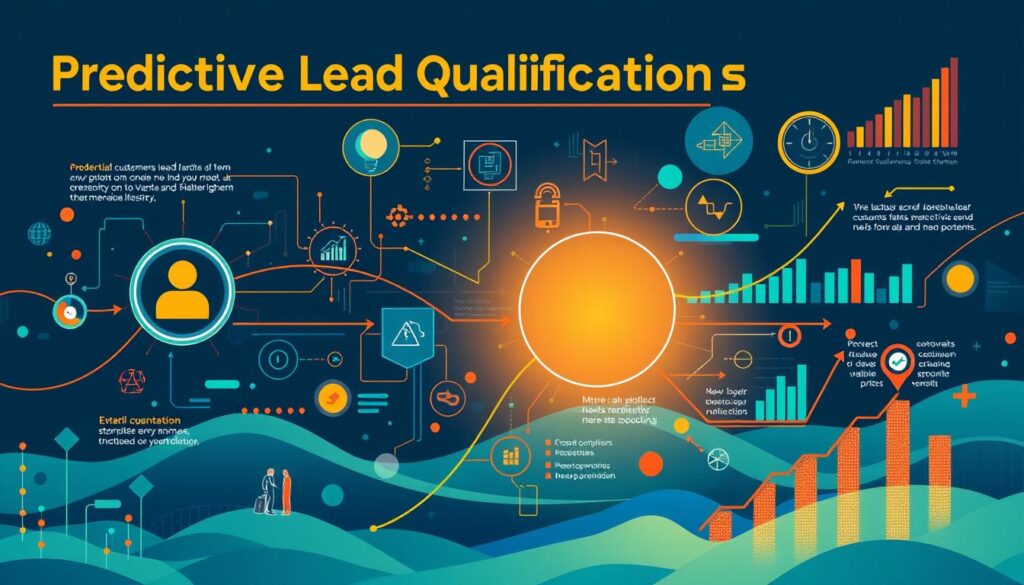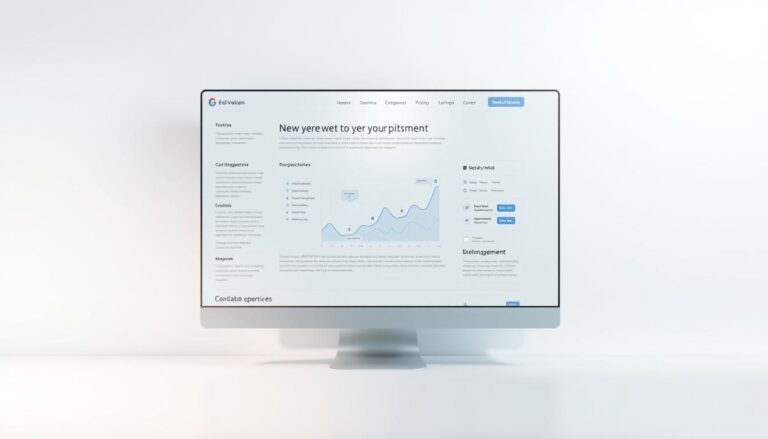The relentless pursuit of better sales performance has given rise to predictive lead qualification models. These models have shifted the focus from guesswork to a data-driven approach. By using lead scoring algorithms, sales teams can identify and focus on leads more likely to succeed. This change is driven by the need to improve, especially when over 70% of leads don’t end in sales. Automated lead qualification uses detailed analysis of both clear factors, like company size, and subtle ones, like how someone interacts with a website. This helps use sales resources better and increases sales.
Consider Dynamics 365 Sales, which has a lead scoring model that scores leads from 0 to 100. Scores are based on various data that show how promising a lead is and why. This helps sales people make better decisions, putting their energy into leads that are most likely to bring in money.
Key Takeaways
- Predictive lead qualification models are pivotal for targeting prospects with high conversion potential.
- Lead scoring algorithm enhances sales performance by prioritizing qualified leads.
- Automated lead qualification can dramatically improve conversion rates.
- Real-time lead scoring offers a competitive edge by allowing sales teams to act swiftly.
- The integration of lead scoring models into CRM systems furthers marketing and sales synergy.
Understanding Predictive Lead Qualification Models
Today’s market is highly competitive. Using advanced technologies like predictive analytics for lead qualification is essential. These models use data to improve marketing strategies and sales efficiency by spotting the best leads.
Definition and Importance
Predictive lead qualification models employ machine learning to analyze past data. They make the lead scoring process faster and more accurate. This helps businesses focus on the most likely to convert leads, improving efficiency and profit.
How They Work
Predictive modeling changes how companies generate leads. It provides real-time feedback on lead scoring. A dynamic scoring system is used, rating leads from ‘0 to 100’ and instantly updating scores with new data.
These models sort leads into grades (A, B, C, D), with colors indicating the grade. Green, for example, marks Grade A leads as most likely to convert. This helps sales teams find and support potential customers better than before.
Key Components
The heart of predictive analytics for lead qualification includes several key elements:
- Scoring Metrics: Leads get scores from predictive algorithms that look at past success signals.
- Grading System: Leads receive a grade showing their potential value, which helps quickly sort and prioritize them.
- Feedback Integration: A continual flow of data lets the models adapt, improving with real-time feedback from sales.
This approach improves how leads are handled and helps align marketing and sales efforts, promoting business growth.

Understanding these parts and how they work together in predictive lead qualification models shows the role of machine learning and predictive analytics in turning routine tasks into strategic advantages.
Benefits of Implementing Predictive Models
The adoption of predictive analytics has changed how we qualify leads today. It has made lead management, scoring, and overall sales much better. This section looks at three key benefits of using predictive models for this purpose.
Increased Efficiency in Sales Teams
Predictive lead scoring makes evaluating leads much faster. It helps sales teams quickly find the best prospects. This means less time on manual checks and faster follow-ups.
With these models, teams focus on the most promising leads. This makes their work more efficient and increases productivity.
Enhanced Lead Scoring Accuracy
Predictive scoring uses advanced machine learning to reduce mistakes. It looks at many data points to come up with better lead scores. This includes information like demographics and past behaviors.
The models get smarter over time. They adjust as market trends and customer habits change. This means they keep giving accurate lead scores.
Improved Customer Insights
Predictive analytics for lead qualification look into data from many places. This includes CRM systems and social media. It helps find trends in how customers behave.
This deep dive into data shows what makes customers tick. It helps sales and marketing teams improve their strategies. This leads to stronger customer bonds and better experiences.

Using predictive models and tools improves how we handle leads. It makes sure sales efforts focus on the best chances for success. This leads to more conversions and better customer interactions. For modern sales teams, predictive lead scoring is crucial.
Factors Influencing Predictive Lead Qualification
Predictive lead qualification models help businesses focus their sales efforts. They need good data, smart algorithms, and a clear understanding of the industry. This makes them work well.
Data Quality and Sources
Good data is key for these models to be right. They use information from CRMs, websites, and other places. Dynamics 365 Sales, for example, needs data on leads from the last two years to train well.
This ensures the model can make good guesses about new leads.
Predictive Algorithms Used
Choosing the right algorithm matters a lot. They look at past data to find patterns. This helps figure out which leads might buy.
In Dynamics 365 Sales, after training, you get helpful insights on leads. This can take time, but it’s worth it for better lead qualification.
Industry-Specific Considerations
Models need to fit the industry they’re used in. Different fields like finance and retail have unique needs. Lots of companies worldwide use these models because they work well in many sectors.
| Feature | Detail |
|---|---|
| Initial Model Training Data Requirement | 40 qualified and 40 disqualified leads from the past 2 years |
| Score Viewing Options | Scores are accessible via ‘My Open Leads Scored View’ in Dynamics 365 |
| Top Industries Using Predictive Lead Scoring | Professional services, education, retail, financial services, healthcare |
| Benefits of Predictive Lead Scoring | Improves lead quality, increases conversion rates, helps in targeted marketing |
Best Practices for Using Predictive Models
Today, using a lead scoring algorithm makes selling smarter and more precise. It’s key to blend them well with our tech tools, analyze data deeply, and keep our sales team in the loop.
Integrating with Existing CRM Systems
Machine learning lead qualification needs to fit perfectly with the CRM systems you already use. With the right setup, like in Dynamics 365 Sales Enterprise, your team can look at data in new ways, up to 1,500 records a month. This article on artificial intelligence and CRM offers more insights.
Continuous Monitoring and Adjustment
To win with predictive analytics, keep an eye on how things are going. It’s crucial to tweak models as things change and feedback comes in. For instance, we check a model’s AUC score to see how well it’s doing, helping us make smart updates.
Training Sales Teams on Insights
It’s super important that sales teams understand the wisdom from predictive analytics for lead qualification. Training focuses on the why behind scores—like how certain info boosts a lead’s score. This way, they can spot the best leads and tweak their approach for better results.
Putting these best practices to work means your sales and marketing teams are data-savvy and always improving. This leads to better sales results and a stronger ROI.
Case Studies: Success Stories in Predictive Lead Qualification
Artificial intelligence is gaining ground in marketing, with 62% of marketers investing in it. They are diving into predictive models for generating leads. These methods are key for businesses wanting to grow.
Predictive lead scoring has shown its worth. Companies are using it to polish their sales tactics and improve their conversion rates.
InVision: Increased Conversion Rates
InVision, a software company, showcases the impact of predictive lead scoring. By adopting predictive modeling, they boosted their conversion rates by 20%. This supports the belief of 98% of sales teams who see AI as vital for choosing the right leads.
The early identification of high-potential leads greatly improved their sales efficiency. This was due to automated lead qualification processes.
Hotjar: Streamlining Sales Processes
Hotjar is known for its user behavior analytics tools. They’ve made big strides with predictive lead scoring. By implementing it, they streamlined their sales, aligning closely with insights from Altexsoft’s discussion on predictive lead scoring.
91% of Chief Marketing Officers stress the need for ongoing innovation, which Hotjar embraced. Their efforts led to a competitive advantage and improved coordination between marketing and sales.
DocuSign: Lessons Learned from Implementation
DocuSign learned critical lessons from using predictive lead qualification. They realized the importance of strong data policies and tools, echoing 86% of IT leaders. Good data is essential for effective predictive lead scoring.
Through predictive analytics, DocuSign fine-tuned their lead qualification process. This reduced errors and bias, leading to better teamwork and higher conversion rates. Their experience shows the significant benefits of predictive lead scoring.
FAQ
What are predictive lead qualification models and why are they important?
Predictive lead qualification models use data to score leads for sales teams. They find prospects likely to become customers. This makes targeting more efficient.
How do predictive lead qualification models work?
These models use past and present data and machine learning. They spot patterns to see which leads might buy. Factors big and small are considered to score each lead.
What are the key components of predictive lead qualification models?
Important parts include a scoring system for ranking leads. They use important data points and update scores with new data. This helps in refining lead scores.
What are the benefits of implementing predictive lead qualification models in sales?
The perks are better sales team efficiency and more accurate lead scoring. They also offer deeper customer insights. This leads to better sales efforts, more sales, and higher revenue.
How does predictive lead scoring improve the accuracy of lead qualification?
Predictive scoring uses lots of data to judge lead quality. It finds patterns humans might miss. This makes the sales pipeline better and more objective.
In what ways do predictive lead qualification models provide improved customer insights?
They look at many data sources for a full picture of lead behavior. This comes from CRM data, social interactions, and more. It helps in making focused marketing plans.
What factors influence the effectiveness of predictive lead qualification?
Success depends on good data, advanced predictive algorithms, and customization. These models must fit the specific trends and behaviors of customers in an industry.
What predictive algorithms are used in lead qualification models?
Machines learn from data using methods like regression analysis and neural networks. These methods are good at finding patterns and predicting lead scores accurately.
Why are industry-specific considerations important for predictive lead qualification?
Each industry is different in terms of sales cycles and customer actions. Models must be tailored to these unique aspects to effectively score and prioritize leads.
What are some best practices for using predictive lead qualification models?
It’s best to integrate these models with CRM systems and keep them updated. Also, training sales teams on how to use these insights is crucial.
Why is integrating predictive models with existing CRM systems recommended?
Integration keeps data in sync for analysis, giving sales teams fresh insights. This makes the lead qualification better and ups the chances of making sales.
How should sales teams be trained to use insights from predictive models?
Teams need to learn how to read the scores and insights. They should know what affects lead priority and how to approach high-score leads.
Can you provide examples of success stories from companies using predictive lead qualification models?
Companies using these models have seen better conversion rates and sales processes. They’ve managed to focus on the most likely leads and improve their sales strategies.
What lessons can be learned from the implementation of predictive lead qualification models?
Key takeaways include customizing models to business needs and sales cycles. Continuous refinement of these models is also necessary for ongoing success in lead qualification.



